LiteLLM vs ggml.ai
Explore the showdown between LiteLLM vs ggml.ai and find out which AI Large Language Model (LLM) tool wins. We analyze upvotes, features, reviews, pricing, alternatives, and more.
In a face-off between LiteLLM and ggml.ai, which one takes the crown?
When we contrast LiteLLM with ggml.ai, both of which are exceptional AI-operated large language model (llm) tools, and place them side by side, we can spot several crucial similarities and divergences. The upvote count reveals a draw, with both tools earning the same number of upvotes. Since other aitools.fyi users could decide the winner, the ball is in your court now to cast your vote and help us determine the winner.
Don't agree with the result? Cast your vote and be a part of the decision-making process!
LiteLLM

What is LiteLLM?
LiteLLM is an innovative platform that specializes in managing large language models (LLMs) effectively for businesses and developers. It streamlines the complex tasks associated with these models by offering load balancing, fallback solutions, and expenditure tracking across more than 100 different LLMs while maintaining the standard OpenAI format compatibility.
This makes integrating and operating multiple LLMs more efficient, reliable, and cost-effective, as it provides features such as adding models, balancing the load between different compute resources, creating keys for access control, and tracking spend to manage budgets better. With LiteLLM, clients have the option of trying their cloud service for free or deploying their open-source solution.
The platform is backed by a robust community, evident from its GitHub repository that has garnered 8.4k stars, over 40,000 Docker pulls, and over 20 million requests served with a 99% uptime. Assistance from over 150 contributors ensures that LiteLLM continues to evolve and meet the demands of users across various sectors looking to leverage the power of LLMs.
ggml.ai

What is ggml.ai?
ggml.ai is at the forefront of AI technology, bringing powerful machine learning capabilities directly to the edge with its innovative tensor library. Built for large model support and high performance on common hardware platforms, ggml.ai enables developers to implement advanced AI algorithms without the need for specialized equipment. The platform, written in the efficient C programming language, offers 16-bit float and integer quantization support, along with automatic differentiation and various built-in optimization algorithms like ADAM and L-BFGS. It boasts optimized performance for Apple Silicon and leverages AVX/AVX2 intrinsics on x86 architectures. Web-based applications can also exploit its capabilities via WebAssembly and WASM SIMD support. With its zero runtime memory allocations and absence of third-party dependencies, ggml.ai presents a minimal and efficient solution for on-device inference.
Projects like whisper.cpp and llama.cpp demonstrate the high-performance inference capabilities of ggml.ai, with whisper.cpp providing speech-to-text solutions and llama.cpp focusing on efficient inference of Meta's LLaMA large language model. Moreover, the company welcomes contributions to its codebase and supports an open-core development model through the MIT license. As ggml.ai continues to expand, it seeks talented full-time developers with a shared vision for on-device inference to join their team.
Designed to push the envelope of AI at the edge, ggml.ai is a testament to the spirit of play and innovation in the AI community.
LiteLLM Upvotes
ggml.ai Upvotes
LiteLLM Top Features
Load Balancing: Efficiently distributes LLM tasks across various platforms including Azure, Vertex AI, and Bedrock.
Fallback Solutions: Ensures continuity of service with fallback mechanisms.
Spend Tracking: Monitors and manages spending on LLM operations.
OpenAI Format Compatibility: Maintains standard OpenAI format for seamless integration.
Community Support: Backed by a strong community of over 150 contributors with resources and documentation.
ggml.ai Top Features
Written in C: Ensures high performance and compatibility across a range of platforms.
Optimization for Apple Silicon: Delivers efficient processing and lower latency on Apple devices.
Support for WebAssembly and WASM SIMD: Facilitates web applications to utilize machine learning capabilities.
No Third-Party Dependencies: Makes for an uncluttered codebase and convenient deployment.
Guided Language Output Support: Enhances human-computer interaction with more intuitive AI-generated responses.
LiteLLM Category
- Large Language Model (LLM)
ggml.ai Category
- Large Language Model (LLM)
LiteLLM Pricing Type
- Freemium
ggml.ai Pricing Type
- Freemium
